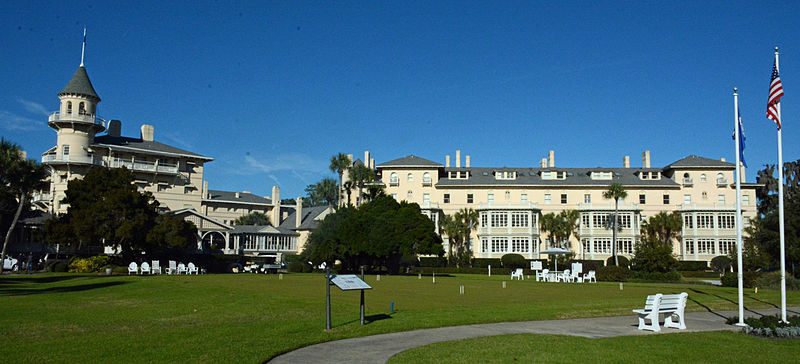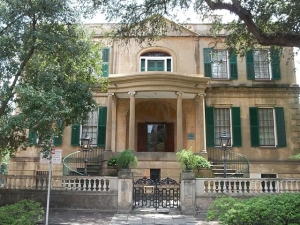I attended the Georgia Association of Assessing Officials (GAAO) 55th Annual Summer Conference on Jekyll Island, Georgia, July 20 and 21. If you are not familiar with Jekyll Island, it was the summer playground for some of the wealthiest families in America in the 1800s and early 1900s. Families with names like Vanderbilt, Morgan, Crane, etc. spent their summers on Jekyll before heading back north at the end of the summer.

The historic Jekyll Island Club, courtesy of Jud McCranie, CC BY-SA 4.0.
On the first day, I attended part of a workshop on specialized assessments, which was taught by Kenny Colson, a property tax appraiser at the Georgia Department of Revenue (DOR). He was kind enough to let me sit in on the class, even though I wasn’t taking it for credit.
His course covered some of the special property tax assessment situations that face tax assessors; these situations often fall outside of the 40% limit, outside the definition of fair market value, etc. [In Georgia, once a fair market value of a property has been established for tax purposes, that amount is multiplied by 40%, and the resulting product is then multiplied by the local millage rate to determine property tax liability. Properties requiring a special assessment fall outside of this typical 40% assessment methodology.]
Mr. Colson focused on GA Statute 48-5-7, which includes brownfield, rehabilitated historic, landmark historic, preferential assessment, conservation use and residential transitional, and forest land properties.
One of the more interesting parts of the workshop was the discussion of brownfields. [As you know, Greenfield has done a lot of work on brownfield properties and has published extensively on the subject. Earlier this year, Dr. John Kilpatrick and I published a book chapter on valuing brownfield properties.1]
The State of Georgia’s definition of a brownfield property is very different from the federal definition from the U.S. Environmental Protection Agency (EPA). The State definition is much more restrictive:
“defined as tangible real property where there has been a release of hazardous waste, constituents and substances into the environment, and an approved corrective action plan or compliance status report for the prospective purchaser has been approved by EPD [the Environmental Protection Division], and a limitation of liability certificate has been issued to the prospective purchaser, and EPD has certified eligible costs of remediation.”
That’s why Colson said there might be only a dozen brownfields across the state. Looking at the EPD website, there seems to be between 50 and 100 brownfields currently across the state.
The EPA definition (which requires that a property have “real or perceived risks”) is broader. The EPA estimates that there are approximately 450,000 brownfields in the United States. Therefore, the much more restrictive State definition of brownfield property is the reason for the lower estimates of the number of brownfields in Georgia at this time.
Next, we discussed rehabilitated historic property and landmark historic properties. As a nice anecdote, Mr. Colson talked about the supposed reason why so many historic properties remain in Chatham County, Georgia. Supposedly, the folks of Chatham County welcomed General Sherman to their county when he and his army arrived toward the end of the Civil War (Sherman’s “March to the Sea”). As the story goes, this is why so many historic properties remain in that county… Sherman didn’t burn them down as he did in other areas, such as Atlanta.
“Rehabilitated historic” properties must qualify for listing on the Georgia Register of Historic Places, and the structures must be substantially rehabilitated (i.e., a residential property must increase in value by 50%; an income-producing property must increase in value by 100%). The property must also meet State Department of Natural Resources (DNR) regulations, and the structure being improved cannot sit on more than 2 acres of land. Also, with rehabilitated historic properties, the assessed value is the purchase price or the fair market value (FMV), whichever is higher. The assessed value is then frozen for 8 years. In the ninth year, assessed value increases to the halfway point between the frozen value and the FMV. In the tenth year, the exemption is removed altogether. If the property sells in an arm’s-length transaction at some point during this time period, then the assessor can raise the assessed value to the sales price if he/she reassesses all other properties in that historic district (for fairness and equity reasons). Only increasing the assessed value of the property of interest (the subject property) does not constitute fairness and equitable treatment to the other properties in the neighborhood.

The Owens-Thomas House, a Historic Landmark in Savannah, Georgia, county seat of Chatham County. Photo courtesy of Wikimedia Commons user Ebyabe, CC BY-SA 3.0.
“Landmark historic” properties were discussed next. These are properties already on the Georgia Registry, which is the key difference between “rehabilitated historic” and “landmark historic” properties. Similar to rehabilitated historic properties, the assessed value is the purchase price or the FMV, whichever is higher, for the first 8 years. In the ninth year, assessed value increases to the halfway point between FMV and frozen value. In the tenth year, the exemption is removed altogether and the assessed value is based on FMV again. All of this applies unless the property is disqualified from the program (called a breach), at which time a financial penalty may apply. Different kinds of property have different breach penalties (e.g., brownfield property owners must pay back two times the tax savings).
Overall, I learned a lot from this workshop and enjoyed speaking on day two about computer-assisted mass appraisal (CAMA) systems and automated valuation models (AVMs), topics that I discussed last month in Amsterdam. A lot of automation is occurring in property tax assessor offices around the state, and we’re available to assist in that automation process so that tax assessor offices can best utilize their resources to provide fair and equitable taxation across their jurisdictions.
1 Kilpatrick, J.A., and C.A. Lipscomb. 2015. “Valuation of Brownfields Properties.” Chapter 29 in Brownfields Law and Practice: The Cleanup and Redevelopment of Contaminated Land (LexisNexis Matthew Bender Publications).






Recent Comments